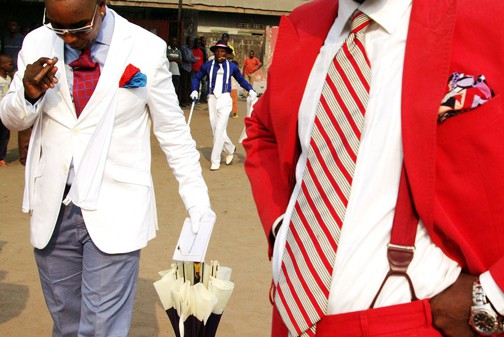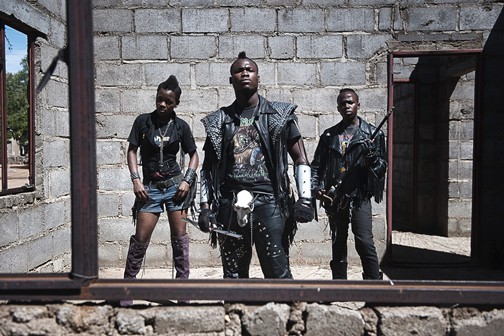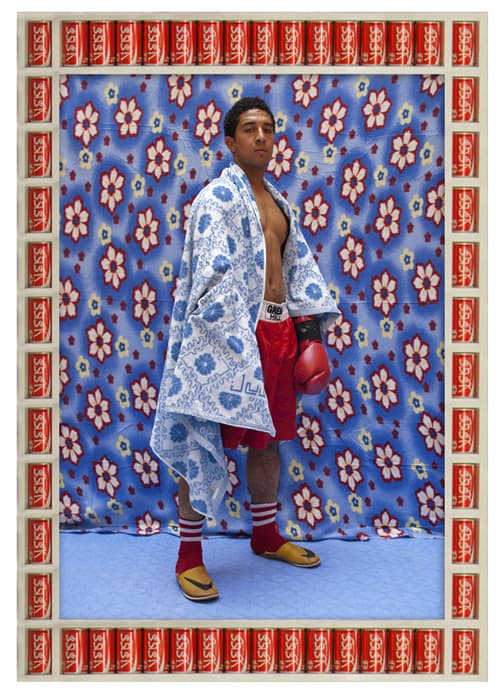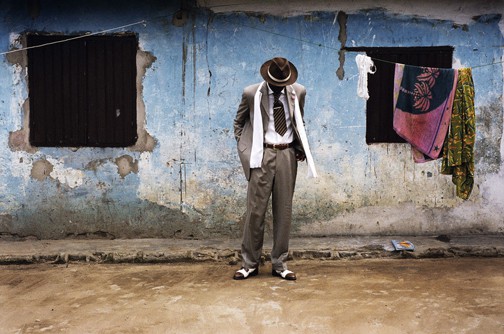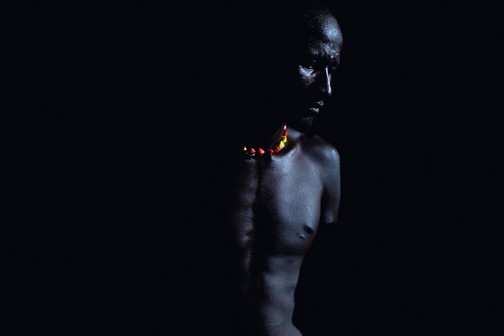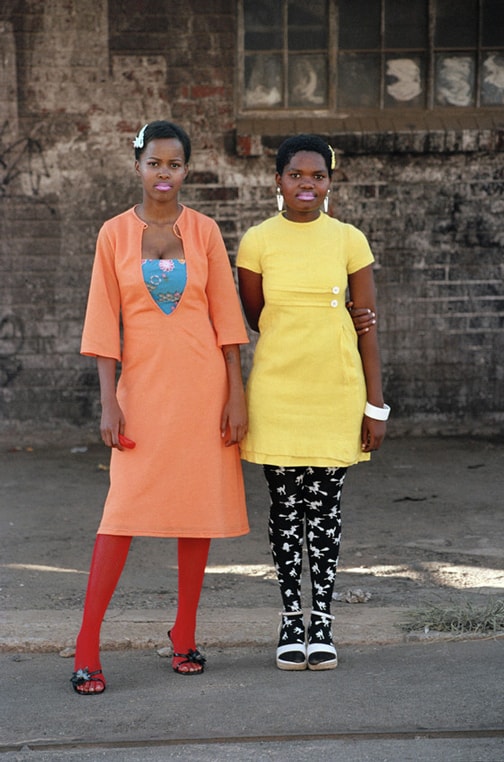From March up to June 2014 Knokke-Heist, Belgium, will once again focus on contemporary photography. The International Photo Festival Knokke-Heist 2014 ensures that there is something for every visitor, with six exhibitions offering various perspectives.
The highlight of the festival is the outdoor exhibition, entitled “Haute Africa”, in which international leading artists and photographers such as Martin Parr, Wangechi Mutu, Zanele Muholi, Viviane Sassen, Yinka Shonibare and many others offer an alternative perspective on the contemporary African continent.
Outdoor exhibition – The Photo Festival’s main exhibition, “Haute Africa”, highlights the work of several leading international photographers in various locations in Knokke-Heist’s public space.
“
Haute Africa” focuses on the work of photographers who are not interested in African fashion per se, but who choose instead to conduct an anthropological study of contemporary African clothing culture. With their fine sense for the various developments in society, they reflect on the various social, political and economic issues that fashion expresses.
Several African countries, including Ivory Coast, Kenya, Nigeria, Tanzania and Zambia have a flourishing economy. South Africa’s economy is the largest in Africa, making it a major global player. These countries primarily owe their progress to the exploitation of the minerals in Africa’s rich soil, but creative and sustainable economies are also seeing growth.
The fashion industry is a good example of such a creative industry. Many African designers, entrepreneurs and photographers inspire the world with new designs that convey and renew African identity. Their creations find their way to the West, through the Internet, during international fashion weeks and thanks to several initiatives aimed at promoting fashion. Artists and photographers soon also noticed this development. They use clothing cultures to better understand the convictions, thoughts and feelings of the wearers or the history of a particular place. They examine such topics as Westernisation, post-Colonialism, race and gender equality, religious beliefs or political power.
The participating artists/photographers are:
Baudouin Mouanda
Baudouin Mouanda, Untitled, from the series, Sapeur de Bacongo, 2008. Courtesy of the Artist.
°1981, Democratic Republic of Congo
Lives and works in the Democratic Republic of Congo
Baudouin Mouanda investigates how global forms of culture and cutting-edge lifestyles influences subcultures within contemporary Congo. His main body of work, Sapeurs de Bacongo, reveals the culture of La SAPE in Congo Brazzaville.
This series show the members of the SAPE community, made up of mostly young men, showing off their flamboyant and brightly coloured suits. The sapeurs have emerged in African and diaspora communities over the past 25 years. Often read as a post-colonial take on the European dandies of the late 18th and 19th century. All together Mouanda shows that being a sapeur is much more than spending tons of money on western designer clothing. Being a sapeur has to do with the way you speak, the way you move,…it’s also a political statement. It’s about changing views about how people see Africa.
In the waning days of civil war, “La SAPE embodies the way of self-expression of a ruptured generation which imposes their codes and transforms fashion into a popular spectacle trying to change the world, even if it’s only for an instant.”
Daniele Tamagni
Daniele Tamagni, Afrometals # 1, from the series, Afrometals, 2012. Lambda C-print, 80 x 57 cm. Courtesy of the Artist.
°1975, Italy
Lives and works in Italy
Set in Congo’s Brazzaville, Daniele Tamagni’s series explores the social and urban context of the ‘Sapeurs’ – which the photographer deems to be “a revolutionary movement, because dressing up is a way to escape and forget poverty. Sapeurs in most cases are humble people and have come from the lower classes and have a dream to escape from Africa and have a better life.” These are juxtaposed by the Sapeurs of Afrometal. In their black leather pants and studded belts, boots and cowboy hats, they could not be further removed from the brightly-coloured suits of their counterparts in Brazzaville, yet, for all their heavy metal references, these Botswana meatheads share with other Sapeurs around the continent a passion to express themselves. While their clothes may have originated in the West, each iconic style has been re-adapted with African iconography.
Tamagni seeks to explore the street style of subcultures in contemporary society. His photographs are a mixture of the ‘staged’ and the ‘in situ’, depending on what occurs at a specific moment. The costumes and the clothes, however, are all real, although Tamagni smiles and says “if they appear to be constructed, then that is good, for I want to leave the viewer questioning what they see.”
Hassan Hajjaj
Hassan Hajjaj, Zezo Tamsamani, 2010/1431. Metallic lambda print on dibond with wood and found objects frame, 76.2 x 111.8 cm / Framed: 93 x 136 cm. Courtesy of the Third Line Gallery, Dubai.
°1961, Morocco
Lives and works in the United Kingdom
Artist and photographer Hassan Hajjaj captures vibrancy, humour and spontaneity in his portraits. The images are presented to create maximum visual impact and grab the attention of any passer-by, not only through the bold use of colour, but also by the direct challenge to the perceived notions of female identity in contemporary Arab culture.
The new Middle East that is emerging is one that is presented in Hassan’s images as bright, bold and assertive, but most importantly, vital. There is something about the style and pose of Hassan’s individuals which brings them very firmly into the discussion about his art. Women often pose in the traditional Hijab or Burqa, but are dressed head-to-toe in designer-label clothes – appearing both assertive and provocative, as if in the pages of Vogue. The images themselves are then hung in bright and clashing frames which are also often constructed by the artist himself.
Héctor Mediavilla
Héctor Mediavilla, B. Mouzieto in Bacongo, 2004. C-print mounted on aluminium, Plexiglas, 70×105 cm. Courtesy of the Artist.
°1970, Spain
Lives and works in Spain
The arrival of the French to the Congo, at the beginning of the 20th Century, brought with it the myth of Parisian elegance among the Congolese youth working for the colonialists. Many considered the white man to be superior because of his technology, sophistication and elegance. According to the legend, in 1922, G.A. Matsoua was the first–ever Congolese to return from Paris fully clad as an authentic French gentleman, which caused considerable uproar and much admiration amongst his fellow countrymen. He was the first ‘Grand Sapeur’.
Respected and admired in their communities, today’s ‘sapeurs’ see themselves as artists. Their refined manners and impeccable style in their attire bring a little glamour to their humble surroundings. Each one has his own repertoire of gestures that distinguishes him from the others. As sapeurs say: ‘The white man invented the suit, we turned it into art.’. They are also after their own great dream: to travel to Paris and to return to Bacongo as lords of elegance.
The media, and the immigrants returning to their countries, keep the myth of the ‘Promised Land’ alive. In this process -consciously or not – our values tend to become myths, and therefore considered superior to the traditional values of other cultures. Although this process has been greatly accelerated in recent times, the problem goes way back, and in the African case, to the colonisation era. In this context, Mediavilla reckons the Congolese ‘SAPE’ to be evidence of the contradictions of our development model.
Jehad Nga
Jehad Nga, Untitled #7828, Turkana, Kenya, 2009. Chromogenic print. Courtesy of Bonni Benrubi Gallery.
°1976, USA
Lives and works in the USA
Sublime and tragic portraits of the Turkana tribe in Kenya are presented here in striking chiaroscuro. Forgotten by a government that hardly felt it to be their own, Kenyaʼs Turkana tribe is withering in numbers as a drought devastates the Horn of Africa.
In a region where little to no aid has reached many of the affected areas, Nga documents in the clearest light possible the people and faces at risk of disappearing as a result of the disaster. Nga removes his subjects completely from their environment by photographing them in a freestanding hut built for this purpose; in doing so, he refuses to allow the harsh terrain of the region to become the defining element of his work, but rather forces the viewer to confront the human subject in front of the lens.
The dress remains a territorial identifier. It is a language unto itself for pastoral tribes. For such groups, defending their land and livestock remains at the forefront of their communal purpose.
Jim Naughten
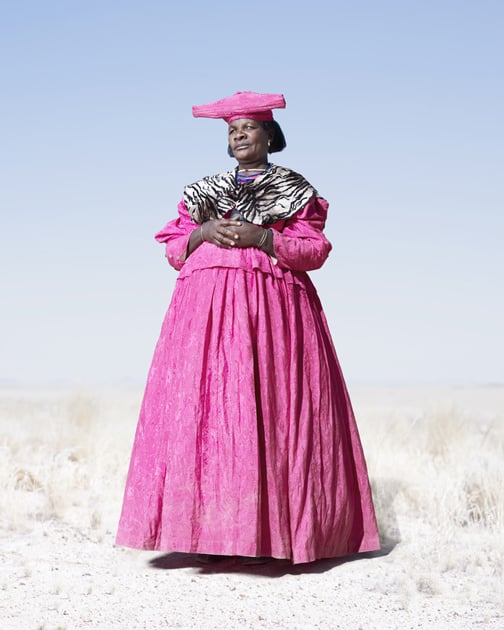 Jim Naughten, Lady in Pink with Zebra Scarf, 2012. Archival C-Print, 41 x 50 inches. Courtesy of Klompching Gallery
Jim Naughten, Lady in Pink with Zebra Scarf, 2012. Archival C-Print, 41 x 50 inches. Courtesy of Klompching Gallery
°1969, The United Kingdom
Lives and works in the United Kingdom
Each image, a portrait of Herero tribe members of Namibia, reveals a material culture that harks back to the region’s tumultuous past: residents wear Victorian era dresses and paramilitary uniforms as a direct consequence of its colonisation.
In the European ‘scramble’ for Africa, Kaiser Wilhelm’s Germany claimed the last corner, ‘Deutsche Sudewest-Afrika’, homeland of the Herero. Rhenish missionaries set about clothing them in the European manner and over time, this became a tradition and a source of pride to the wearer.
War broke out in 1904 devastating the Herero, who lost up to 80% of their people. Garments became an important expression of identity during those fragile times. After killing a German, a Herero would adopt the uniform to acquire the enemy’s spirit and show prowess in battle. Paradoxically, the wearing of those uniforms has become a tradition that continues to this day by men who ritually honour their ancestors during ceremonies, festivals and funerals.
By composing these portraits against the Namibian landscape — one of unforgiving intensity but also of silent witness — there is an enlivening that takes place in an otherwise frozen moment. The still space, the direct gaze and the re-appropriated clothing combine to create a stillness that allows the past to speak.
Jodi Bieber

Jodi Bieber, Tshepiso, 2008. Digital print in pigment inks, 162 x 220 cm. Courtesy Goodman Gallery Johannesburg/Cape Town
°1966, South Africa
Lives and works in South Africa
This project was realised through a number of experiences – a Dove billboard advertising campaign in London showing ordinary women in their underwear advocating and speaking up for real beauty. A model sitting next to Bieber on the way from London to Paris emphasised the extent to which Photoshop is used to enhance beauty. She was not in the least bit concerned about the rings under her eyes since these imperfections would easily be erased after her photo shoot. A BBC radio documentary spoke about an increase in the cases of anorexic black women in South Africa, as the full figured body which was once more favoured, is no longer as desirable as Western body shapes.
She felt a strong need to create a body of work that goes against what the media has depicted as beautiful. Even within a complex society such as South Africa, across all communities, women hold unnecessary perceptions of self-doubt about themselves and their beauty from an early age.
Different belief systems are held amongst different communities. Sometimes the belief is that very thin and tall women are perceived as being sick, possibly with HIV and fuller-figured women as healthy in some communities. In others, thin women are often more desirable.
The series created a space for each woman to explore her own identity, in relation to an understanding of beauty, and to live for a couple of hours in an environment of fantasy. She shares a common ground with the women whom she photographed, which is a wish to make a stand for ‘real beauty’.
Namsa Leuba
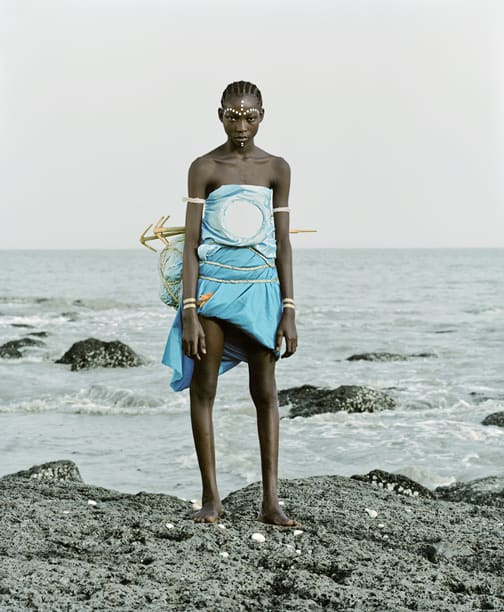 Namsa Leuba, Vili statuette, Fanta, Guinea, 2011. C-print, 28 x 35 cm. Courtesy of the artist.
Namsa Leuba, Vili statuette, Fanta, Guinea, 2011. C-print, 28 x 35 cm. Courtesy of the artist.°1982, Switzerland
Lives and works in both France and Switzerland
In this work, Namsa Leuba focuses on African identity through the Western lens. Raised by a Swiss father and a Guinean mother, she was exposed to two different cultures from a young age. Fascinated by her mothers’ native country, Leuba studied cultural practices and rituals from the region of Conakry, Guinea in West Africa.
In Guinea, Islam is the majority religion followed by Christianity. But like many cultures where mass conversion has taken place, devotion to an earlier religion is still common, and seven percent of the population still practice the traditional Guinean animist faith. In Guinean cosmology ritual statuettes are used symbolically to represent “modesty, luck, fecundity or a channel for exorcism.” The statuettes are typically used in ceremonies to represent the yearnings of the worshipers – they are “not the gods of this community,” Leuba writes, “but their prayers.”
Leuba has staged portraits where human models play the parts of the traditional statuettes. She asked her subjects to dress in complicated garments representing the ritual tools. According to the type of statuette and their functions, different materials were used. In putting these sacred objects into a different context through the lens, Leuba has brought them into a framework meant for Western aesthetic choices and taste, and has made them speak differently.
Nontsikelelo Veleko
Nontsikelelo Veleko, Beauty is in the Eye of the Beholder: Cindy and Nkuli, 2003. 29,6 x 19,7cm, Pigment inks on cotton rag paper. Courtesy of the Goodman Gallery
°1977, South Africa
Works and lives in France
Veleko’s signature theme of Beauty is in the Eye of the Beholder, a series of crisp, bold street fashion portraits of youth culture and fashion in South Africa feature strongly again, but begin here to quiver almost imperceptibly in their frames. These series are a familiar continuation of the series that she began in 2003, and that won her broad international recognition.
Veleko has been a dedicated documenter of fashion and bold, individual style. More than that, though, she has asked questions about how we read fashion and about how her subjects use clothes to construct, and often deconstruct, their guises of identity. Her photographs have opened an interesting window on to aspects of South Africa’s cultural makeup over the past five years.
Veleko’s subjects are rarely mainstream individuals. Many of them are characters that take risks in the ways that they declare themselves in the world and in so doing are often vulnerable within the domains that they inhabit, often at the edge of society. And some clearly reflect critical shifts that are taking place on that edge- Tracy Murinik
Martin Parr
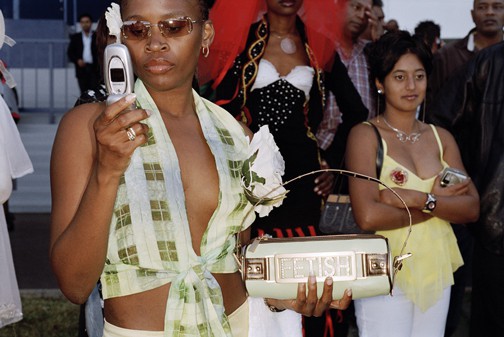 Martin Parr, South Africa. Durban. July Races, 2005. Courtesy Martin Parr / Magnum Photos
Martin Parr, South Africa. Durban. July Races, 2005. Courtesy Martin Parr / Magnum Photos
°1952, United Kingdom
. Lives and works in the United Kingdom
Luxury
This series of photographs tries to depict the wealthy of the world relaxing and enjoying themselves at various art fairs, fashion shows, horse racing and polo events. I started this project in the middle of the last decade, well before the global crash of 2007/2008, when it seemed there was no end to the craziness and growth of the world economies. After the crash, when I was starting to finish this particular project, I thought of it more of an epitaph to that particular period. Now, a few years later, we know that there are more wealthy people in the world than ever, but there is a little more circumspection than before.
The selection includes a good few images from the Durban July, the biggest horse racing event in South Africa. I decided to visit this event to see how the new South Africa would present itself at a big social occasion. Sure enough, the wealthy whites with their old money were out in force, but we also saw the new wealthy blacks enjoying themselves, sometimes now even being served by the whites!
For this project, I’ve also ventured into the emerging BRIC countries and the Middle East. I went twice to Dubai, for example as it emerged as a regional centre for wealth creation and high spending, and although their crash was a bit later than the rest, they too are now back to the original growth rate.
In the humanitarian school of thinking within photojournalism, depicting poverty is an accepted topic. In one way, I photograph wealth with the same spirit: we are all in danger of creating an unsustainable global economy, and the wealthy of the world are part of this new equation. However I also try and create entertainment through my images, but if you look closely at them, you will see that they contain many ambiguities.
Phyllis Galembo
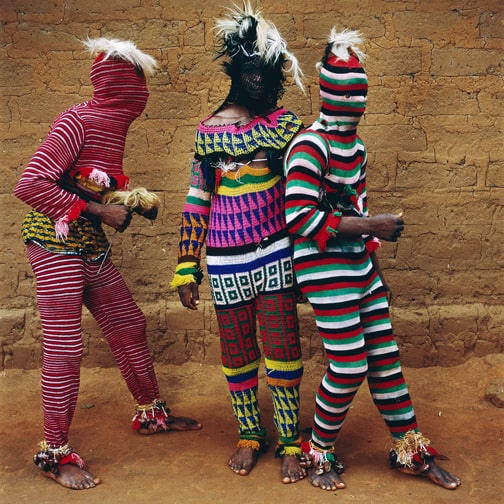 Phyllis Galembo, Ngar Ball Traditional Masquerade Dance, Cross River, Nigeria, 2004. Ilfochrome, 76 x 76 cm. Courtesy Phyllis Galembo and Steven Kasher Gallery, New York / Alex Daniëls – Reflex, Amsterdam.
Phyllis Galembo, Ngar Ball Traditional Masquerade Dance, Cross River, Nigeria, 2004. Ilfochrome, 76 x 76 cm. Courtesy Phyllis Galembo and Steven Kasher Gallery, New York / Alex Daniëls – Reflex, Amsterdam.
°1952, USA
Lives and works in USA
Phyllis Galembo photographically documents the transformative power of ritual dress in Africa and the Americas.
Masking, which is practiced primarily by men but also women and children, is part of the contemporary African life in many ways. Each community has its own style and use for masquerade, including initiation rituals, weddings, funerals, coronations, and secret societies.
Contemporary masquerade rituals are often entertaining, humorous, dark or frightening- an amazing mix of foreign and traditional. African artists who create both the mask and the costume have “relentlessly widened the horizon of stylistic possibilities, sometimes through stunning economy of means and materials, even as they maintain a dynamic relationship with forms prescribed by tradition” according to art historian Chika Okeke-Agulu. Phyllis Galembo continues to search for beauty and soul in the great artistic tradition of masquerade.
Sabelo Mlangeni
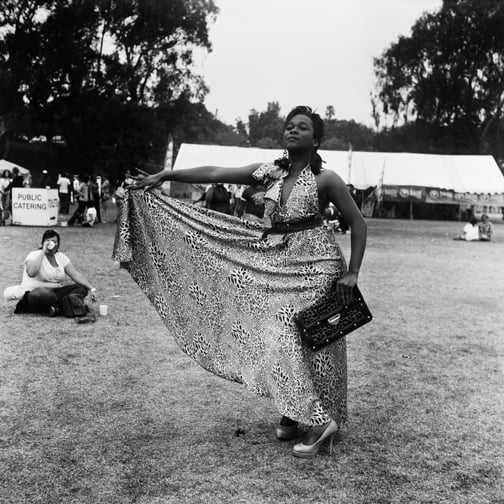 Leopard, 2011. Hand-printed silver gelatin print. Image size: 36 x 36cm, Paper size: 40 x 50cm. Edition of 7 + 2AP – Courtesy of the Artist and Stevenson Cape Town/Johannesburg
Leopard, 2011. Hand-printed silver gelatin print. Image size: 36 x 36cm, Paper size: 40 x 50cm. Edition of 7 + 2AP – Courtesy of the Artist and Stevenson Cape Town/Johannesburg
°1980, South Africa
Works and lives in South Africa
Black Men in Dress comprises a series of portraits photographed at the Johannesburg and Soweto Pride, a yearly event for the Lesbian, Gay, Bisexual, Transgender and Intersex (LGBTI) community. These portraits remind Mlangeni of a childhood where, as he describes:
“Most communities had what we call ‘uSis’bhuti’. This is a term used to describe a boy who behaves like a girl. Why then do we hate these boys when they have grown up to be men who dress as women? Why do we turn and call them names, pretending that we’ve never seen it?”
As in Mlangeni’s previous series Country Girls, a dramatic sense of fashion and a performative and playful manner is explored by gay men to engage with their sense of belonging and identity. The performative elements of exhibitionism and ritual tie together these two seemingly different bodies of work, in which urban, homosexual celebration is juxtaposed with rural, heterosexual tradition.
Viviane Sassen
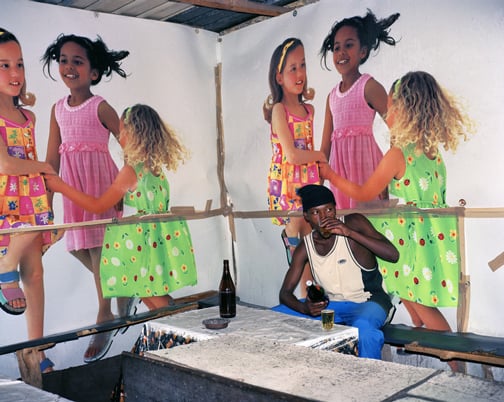 Viviane Sassen, Untitled, from the series, Die Son Sien Alles 2002/2004. Book by Libraryman. © VivianeSassen
Viviane Sassen, Untitled, from the series, Die Son Sien Alles 2002/2004. Book by Libraryman. © VivianeSassen
°1972, The Netherlands
Lives and works in Holland
Viviane Sassen photographed the townships of Cape Town during several visits between 2002 and 2004, depicting the ramshackle inventiveness with which poor black South Africans construct their living environment.
In this project, Sassen continues her equally playful and incisive explorations of contemporary African culture. The series is a study of the living environment in the South African townships and reveals the sculptural qualities of the interiors in combination with Western objects which seemed to seep through daily life. Many of the interiors are made out of fashion advertisements, patterned fabrics and wallpaper from fashion magazines. The images are invariably intriguing and remarkable, even somewhat surreal. Are they portraits? Documentary work? Stage advertising? Conceptual? They engage all those vernaculars, pulling from each their best representational strategies, and in the end capture their subjects in a more humane and engaged way than much photography of Africa. These people seem real, the shebeen drinkers at ease. Life, even as strange and slightly off as it seems to be in these images, is happening.
Over the course of her career, Viviane Sassen has produced a flood of marvellous images, many of which are of Africa, the continent in which she spent much of her youth.
Wangechi Mutu
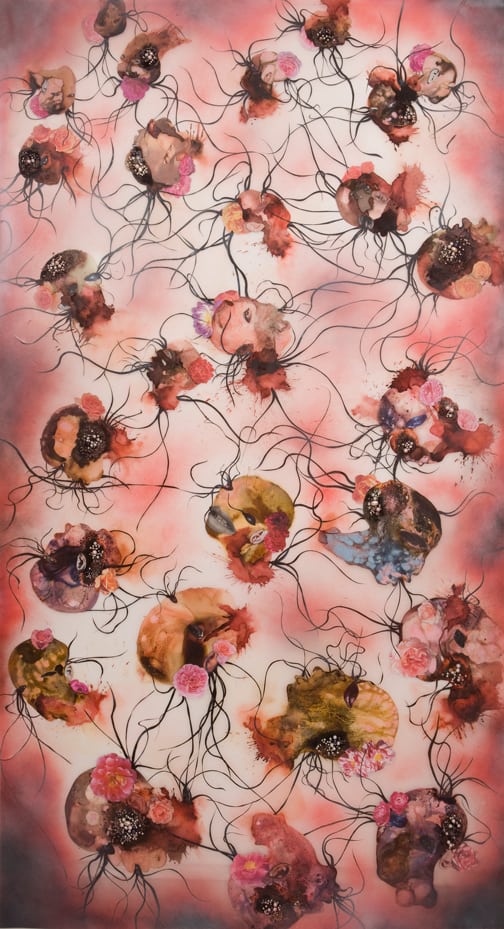 Wangechi Mutu, Fallen Heads, 2010. Collage, ink, mixed media on Mylar. 154.94 x 271.78 x 6.35 cm. Courtesy of the Artist and Susanne Vielmetter Los Angeles Projects; Collection of Paul and Linda Gotskind, Chicago, IL.
Wangechi Mutu, Fallen Heads, 2010. Collage, ink, mixed media on Mylar. 154.94 x 271.78 x 6.35 cm. Courtesy of the Artist and Susanne Vielmetter Los Angeles Projects; Collection of Paul and Linda Gotskind, Chicago, IL.
°1972, Kenya
Works and lives in USA
From a distance, Wangechi Mutu’s Fallen Heads could be a blushing floral pattern. Up close, the decorative quality remains intact: blooms of watercolour bloodstain the background and collaged flowers and jewels ornament the falling, rolling heads. Sinuous black lines that resemble hair, connective tissue, and neurons emerge from the heads. The motif is evocative of colourful and complex patterns of flora and fauna, cellular growth, and severed flesh. The bejewelled and disembodied heads invoke the history of state-ordered and guerrilla executions, reminding the viewer that taking life in public is a ritual of retribution or an assertion of religious and political power. This jumble of heads synthesises Mutu’s criticisms of various leadership failures that have led to the contemporary authorisation of these brutal practices with her attention to more subtle representations of power and violence in popular entertainment.
Wangechi Mutu is best known for her large and expressive collages and sculptural installations. She combines images from popular magazines, ethnographic periodicals, and pornography with expressive applications of paint, ink, glitter, and even hair to address racial identity, neo-colonialism, African politics, and dominant representations of women. The resulting work is complicated and strange, beautiful and terrifying- Ariel Lauren Pittman.
Yinka Shonibare MBE
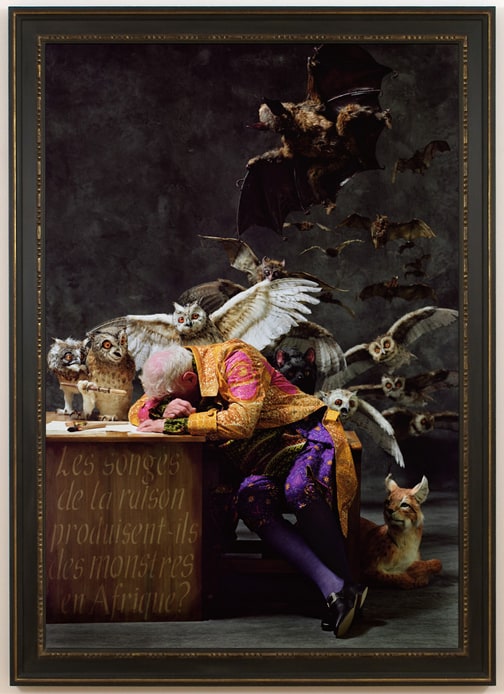 Yinka Shonibare, MBE. The Sleep of Reason (Africa), 2008. C-print mounted on aluminum, 207 x 147.3 x 6.4cm. Courtesy of the artist and Stephen Friedman Gallery, London.
Yinka Shonibare, MBE. The Sleep of Reason (Africa), 2008. C-print mounted on aluminum, 207 x 147.3 x 6.4cm. Courtesy of the artist and Stephen Friedman Gallery, London.
°1962, United Kingdom / Nigeria
Lives and works in the United Kingdom
Shonibare’s work explores issues of race and class through the media of painting, sculpture, photography and film. Having described himself as a ‘post-colonial’ hybrid, Shonibare questions the meaning of cultural and national definitions. His trademark material is the brightly coloured ‘African’ batik fabric he buys at Brixton market. The fabric was inspired by Indonesian design, mass-produced by the Dutch and eventually sold to the colonies in West Africa. In the 1960’s the material became a new sign of African identity and independence.
‘The Sleep of Reason (Africa)’ is an appropriation of Francisco Goya’s ‘El Sueño de la Razón Produce Monstruos’ (‘The Sleep of Reason Produces Monsters’, or ‘The Dream of Reason Produces Monsters’). Here, Shonibare photographs a real person wearing Victorian-style garments made from richly-hued African textiles. Shonibare emphasizes the complexity of cultural identity while arguing for a delicate balance between fantasy and the real, a sentiment shared by Goya, who warned, “Imagination deserted by reason, begets impossible monsters. United with reason, she is the mother of all arts, and the source of their wonders.”.
Shonibare’s photographs ask in French: “Les songes de la raison produisent-ils les monstres en Afrique/en Amérique/en Asia/en Europe/en Australie?” (“Do the dreams of reason produce monsters in Africa/in America/in Asia/in Europe/in Australia?”). This translation seems to suggest that the imposition of the Enlightenment ideals may in fact create a few demons–such as dictators “democratically” voted into power.
Zanele Muholi
Zanele Muholi, Lebo ‘Leptie’ PHUME, Daveyton, Johannesburg, 2013. Silver gelatin print, 76.5 x 50.5cm / 86.5 x 60.5cm. CourtesyZanele Muholi and Stevenson Cape Town/Johannesburg
°1972 South Africa
Lives and works in South Africa
This series presents black gay (LGBT) young people from various townships in South Africa. They are mainly black lesbians, who grew up under the new dispensation of the democratic South Africa; the so-called ‘Born Frees’. Their realities may not be the same as those who lived under Apartheid, but they still live under the shadow of violence, rampant hate crimes and a high unemployment rate.
This is the battle in which this ‘Born Free’ generation is engaged: the struggle to love, to express their sexuality freely without fear of recrimination, overt violence or ‘corrective rape’. This self-expression is also apparent in the way each person chooses to dress.
Through the gender-specific codes of clothing, these young people claim and assert their space to exist. For example, a ‘butch’ lesbian adopts masculine fabrics which allow the wearer to pass as a man, while ‘femme’ lesbians choose to make a statement in feminine or sexy clothing. Some adopt African couture or traditional beadwork to contest the notion that gayness/homosexuality is ‘unAfrican’. Others dress in a particular way simply because it makes them feel comfortable. This boldness and confidence defines each person’s existence, making them visible, allowing individuals to be recognised and respected.
This work acknowledges the realities of young gays whose bodies have declined and aims to amplify the political weight of those who are present and alive in defiance of that intolerance and violence, who assert their own space within this young democracy.
